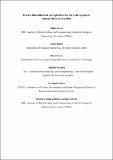Process intensification and optimization for hydroxyapatite nanoparticles production
Author(s)
Castro, Filipa; Kuhn, Simon; Jensen, Klavs; Ferreira, António; Rocha, Fernando; Vicente, António; Teixeira, José António; ... Show more Show less
DownloadAccepted version (1.407Mb)
Terms of use
Metadata
Show full item recordAbstract
Precipitation processes are widely used in industry for the production of particulate solids. Efficient mixing of the reagents is of major importance for the chemical and physical nature of the synthesized particles. Recently, microreactors have been studied to overcome homogeneity problems found when using stirred tank batch reactors. The present work investigated an ultrasonic tubular microreactor for the continuous-flow precipitation of hydroxyapatite (HAp), both in single-phase flow (SPF) and in gas-liquid flow (GLF). HAp nanoparticles were yielded for both configurations under near-physiological conditions of pH and temperature. The as-prepared particles, especially those that were prepared under GLF, show improved characteristics compared to commercial powder or powder obtained in a stirred tank batch reactor. Primary particles are smaller, particle shape is more homogeneous, and the aggregation degree of the particles is lower. © 2013 Elsevier Ltd.
Date issued
2013Department
Massachusetts Institute of Technology. Department of Chemical EngineeringJournal
Chemical Engineering Science
Publisher
Elsevier BV
Citation
Castro, F., et al. "Process Intensification and Optimization for Hydroxyapatite Nanoparticles Production." Chemical Engineering Science (2013).
Version: Author's final manuscript